As the first signs of spring emerge, tulips grace gardens, parks, and public spaces with vibrant colors and elegant forms. These beloved blooms have captivated people’s hearts worldwide for centuries, inspiring art, culture, and endless fascination. The story of the tulip stretches far back in history, its origins rooted in ancient lands and civilizations, blossoming into a symbol of wealth, love, and the enduring beauty of nature.
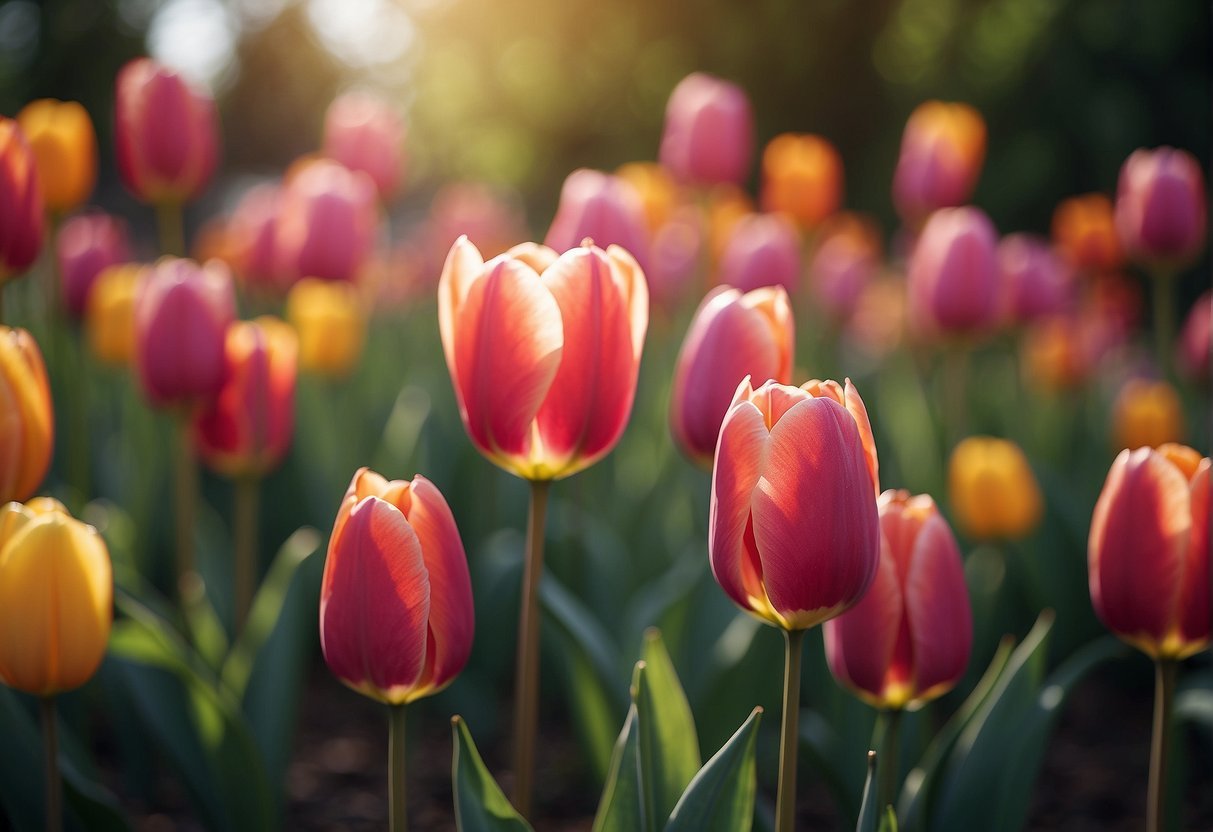
Today, a staggering array of tulip varieties adorns the landscapes of countries near and far. From the humble but charming wild tulips to the dramatic, frilled parrot tulips, these blossoms offer endless possibilities for gardeners, floral designers, and nature lovers alike. Achieving a breathtaking spring display can be an enjoyable and rewarding experience. With proper planting, care, and attention to the tulip’s growth cycle, a vibrant kaleidoscope of colors can come to life in any setting.
Key Takeaways
- Tulips create vibrant colors and elegant forms in various landscapes during spring.
- The story of tulips stretches centuries back, symbolizing wealth, love, and natural beauty.
- Various tulip types exist, with proper planting and care leading to breathtaking displays.
The History of Tulips
Origin of Tulips
The tulip, a symbol of beauty and grace, originated in the mountain ranges of Central Asia, particularly in present-day Kazakhstan. From there, it spread across Asia Minor and made its grand entrance into Europe in the 16th century. Ogier Ghiselin de Busbecq, the ambassador to the Holy Roman Emperor Ferdinand I, is credited with introducing tulips to Europe and cultivating them in Austria.
The Netherlands quickly took the lead in tulip cultivation and trade, eventually leading to the Dutch Tulip Mania of the 1630s. This period saw a rapid increase in tulip prices, with single bulbs trading for exorbitant amounts. The tulip bubble burst in 1637, but it left a lasting impact on Dutch cultural history, and the Netherlands remains a global frontrunner in tulip production.
Tulips in Art and Culture
Tulips have been a recurring theme in various forms of arts and culture throughout history. Some prominent examples are:
- Tulip motifs in Islamic art: In the Ottoman Empire, the tulip was a revered symbol of love, perfection, and God’s blessings. Sophisticated tulip motifs adorned textiles, tiles, and metalwork. Italic society embraced the Lale Devri or ‘Age of Tulips,’ an era in which tulip-shaped fountains, gardens, literature, and poetry flourished.
- Dutch Golden Age paintings: The Dutch Golden Age of the 17th century was a time of prolific artistic output, with numerous artists featuring tulips in their subject matter. Painters like Ambrosius Bosschaert the Elder, Jan van Huysum, and Maria Sibylla Merian captured the allure and splendor of tulips in their still-life works, boosting the flower’s symbolic value within Dutch society.
- Contemporary art: Tulips continue to captivate artists today, such as world-renowned British artist Damien Hirst. In his abundant series, Hirst depicts a variety of tulips in his characteristic style using formaldehyde, thus rendering the flowers eternal.
Varieties of Tulips
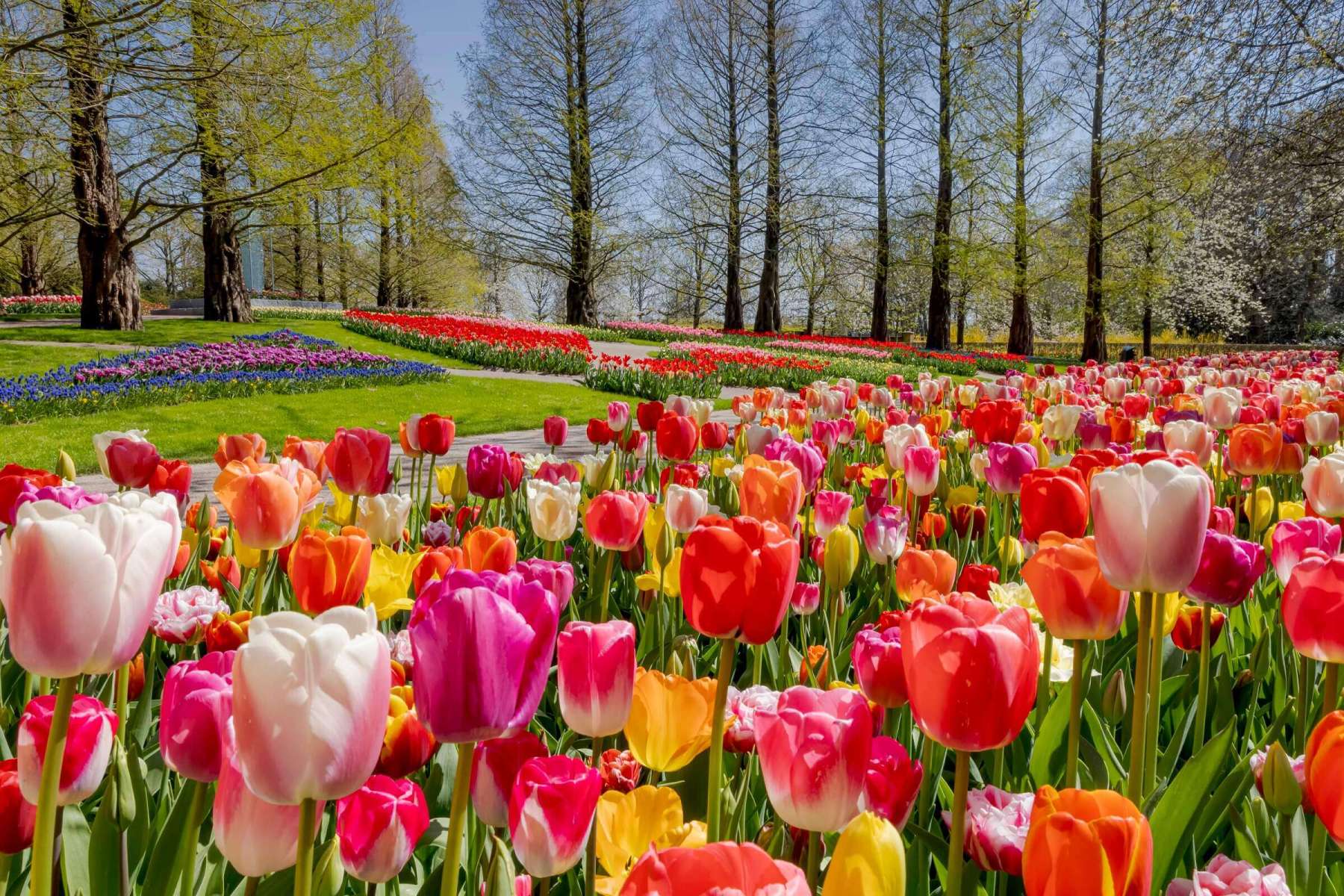
Tulips are a popular spring flower that comes in many delightful colors. They are typically classified into three blooming groups: early-blooming tulips, midseason-blooming tulips, and late-blooming tulips. Each group has unique characteristics and bloom times so that gardeners can enjoy a continuous display of tulips throughout the season.
Early Blooming Tulips
As their name suggests, early-blooming tulips are the first to appear in spring. They typically begin to bloom in late March to early April.
Some famous early-blooming tulips include:
- Single Early Tulips: Compact and sturdy, these tulips have single cup-shaped flowers that can withstand harsh weather conditions.
- Double Early Tulips: Known for their stunning, peony-like blooms, these tulips have multiple layers of petals, giving them a complete, lush look.
- Kaufmanniana Tulips: Waterlily tulips have star-shaped flowers that open fully in sunlight, resembling waterlilies.
Mid-season Blooming Tulips
Mid-season blooming tulips provide a striking show of color from mid-April to early May. Some popular varieties in this category include:
- Triumph Tulips are crosses between single early and late tulips. They boast a wide range of colors and are known for their sturdy stems, making them ideal for cut flowers.
- Darwin Hybrid Tulips: With large blooms and strong stems, Darwin hybrids can grow up to 24 inches tall and are famous for their impressive color combinations.
Late Blooming Tulips
Late-blooming tulips are the last to appear in the season, with blooms typically appearing from late April through May. Some of their popular varieties are:
- Single Late Tulips: Featuring tall stems and large, oval blooms, these tulips can add a dramatic touch to any garden.
- Double Late Tulips: Also known as peony tulips, these tulips have lush, double blooms that offer a showstopping display.
- Viridiflora Tulips: Unique due to the green streaks found on the petals, these tulips provide an interesting contrast to other tulip varieties.
By planting a mix of early, mid, and late-blooming tulips, gardeners can create a vibrant, ever-changing display from late March through May.
Planting and Care
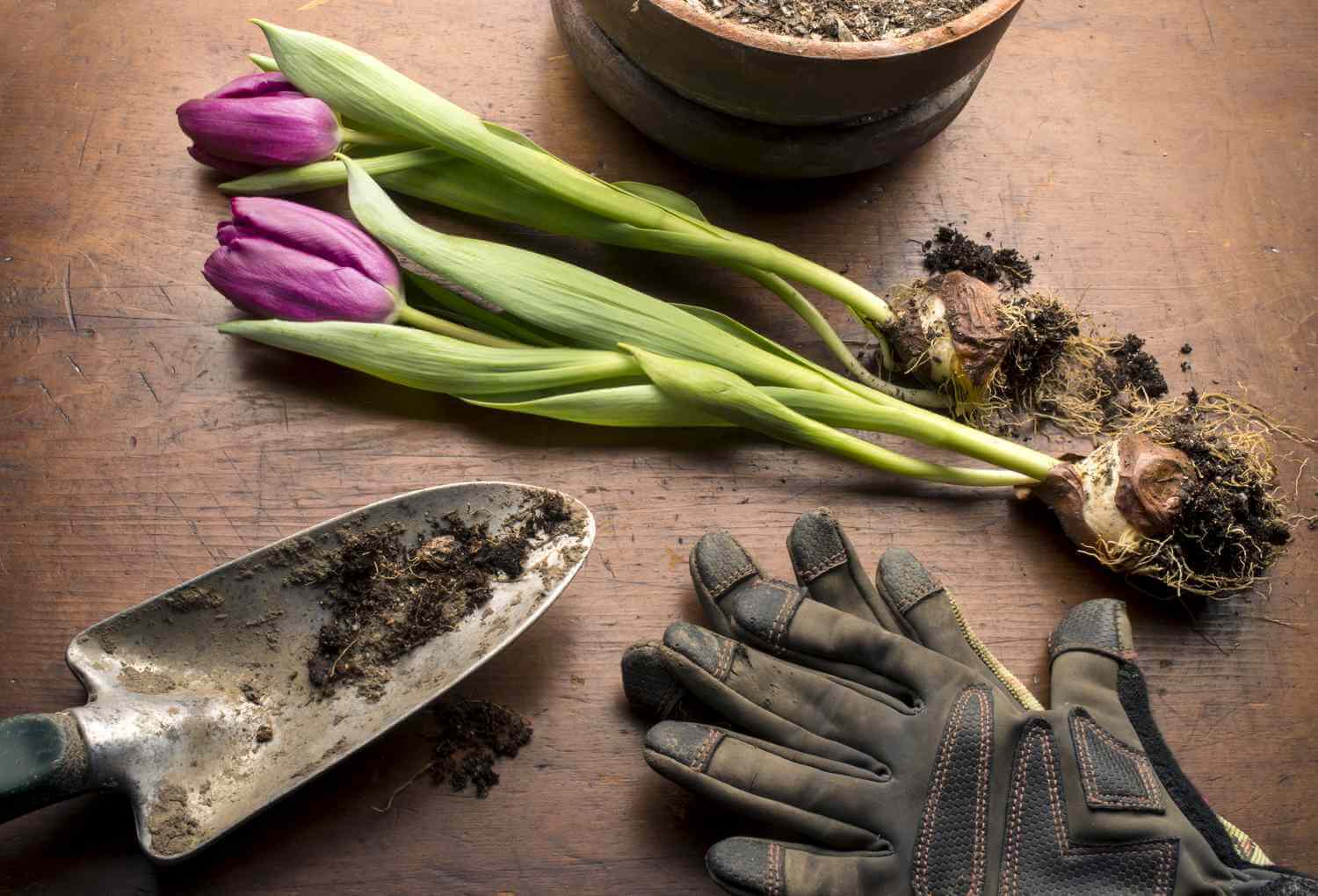
Soil and Sunlight Requirements
Tulips thrive in well-draining, fertile soil with a pH between 6.0 and 6.5. Amend your garden soil with organic matter, such as compost, to improve drainage and fertility. Tulips enjoy full sunlight, so select a planting location that receives at least 6 hours daily.
Watering and Fertilization
Water tulips frequently during their growth period, maintaining consistently moist soil. However, avoid overwatering, as it can lead to root rot. Allow the soil to dry slightly between waterings. Fertilize tulips by following the guidelines below:
- Before planting: Apply a balanced, slow-release granular fertilizer.
- After flowering, Apply a high-potassium liquid fertilizer. This helps promote solid bulbs for next year’s growth.
| Fertilization Time | Fertilizer Type |
|---|---|
| Before planting | Balanced, slow-release |
| After flowering | High-potassium liquid |
Pest and Disease Control
Monitor tulips for common pests, such as aphids, slugs, and snails. Treat infestations promptly with pest control methods, such as insecticidal soaps or diatomaceous earth. For disease prevention, ensure proper spacing between plants for adequate air circulation. Remove and dispose of any infected plants immediately to prevent the spread of disease. Some common tulip diseases include:
- Tulip Fire: This fungal disease causes spots on leaves and distorted growth. As a preventative measure, use a fungicide.
- Botrytis: This gray mold thrives in damp, excellent conditions. To prevent it, minimize humidity and allow sufficient air circulation around plants.
In summary, proper soil preparation, a sunny location, regular watering, timely fertilization, and vigilant pest and disease control will ensure a healthy, vibrant tulip garden in the spring season.
Tulip Growth Cycle
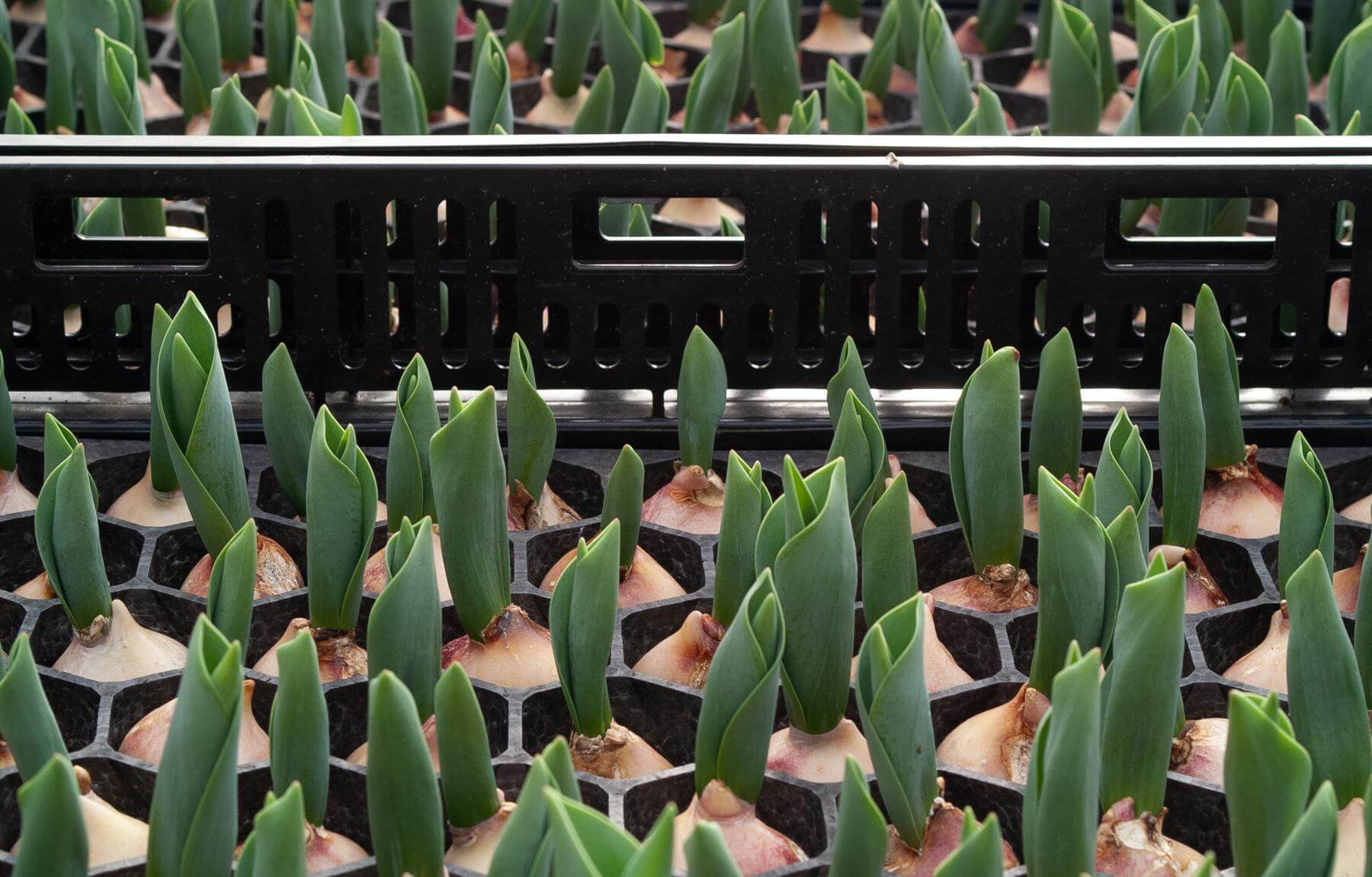
Germination
The tulip germination begins when a planted bulb absorbs moisture and warmth from the soil. This triggers the growth of the shoot, which emerges from the bulb and starts to grow upwards. Germination typically occurs in autumn, allowing enough time for the tulip to develop strong roots before winter dormancy. This process ensures the plant has a solid foundation for the next growth stage:
- Root formation: The bulb sends roots that anchor it in the soil and gather nutrients as they grow.
- Shoot development: The shoot grows upwards, breaking through the soil’s surface and stretching towards sunlight.
Stem and Leaf Growth
Stem and leaf growth commences following germination. As the tulip’s shoot emerges from the soil, it forms a stem that can grow up to 30 inches tall, depending on the tulip variety. Alongside stem growth, the tulip produces leaves – typically a few elongated and broad leaves per stem.
| Growth stage | Duration |
|---|---|
| Early growth | 3-4 weeks |
| Mid growth | 5-6 weeks |
| Late growth | 7-8 weeks |
The stem and leaf growth process allows the tulip to:
- Absorb sunlight: The plant uses this energy to undergo photosynthesis and create necessary nutrients.
- Store energy: Throughout its growth stage, the tulip stores energy in carbohydrates, which is helpful for the subsequent flowering stage.
Flowering
The final stage in the tulip growth cycle is flowering. It generally occurs during springtime, with various tulip species blooming at different times throughout the season:
- Early blooming: These tulips flower in late March or early April, marking the beginning of spring.
- Mid-season blooming: These varieties bloom around mid-April to early May.
- Late blooming: Late-season tulips flower from May onwards, extending the colorful display of spring.
Each tulip species has unique petal colors, shapes, and sizes, adding to the visual splendor during the flowering season. Flowering typically lasts for around two to three weeks, after which the tulip’s petals will wither, and the plant enters a period of dormancy, awaiting the next growth cycle.
Tulip Festivals and Events
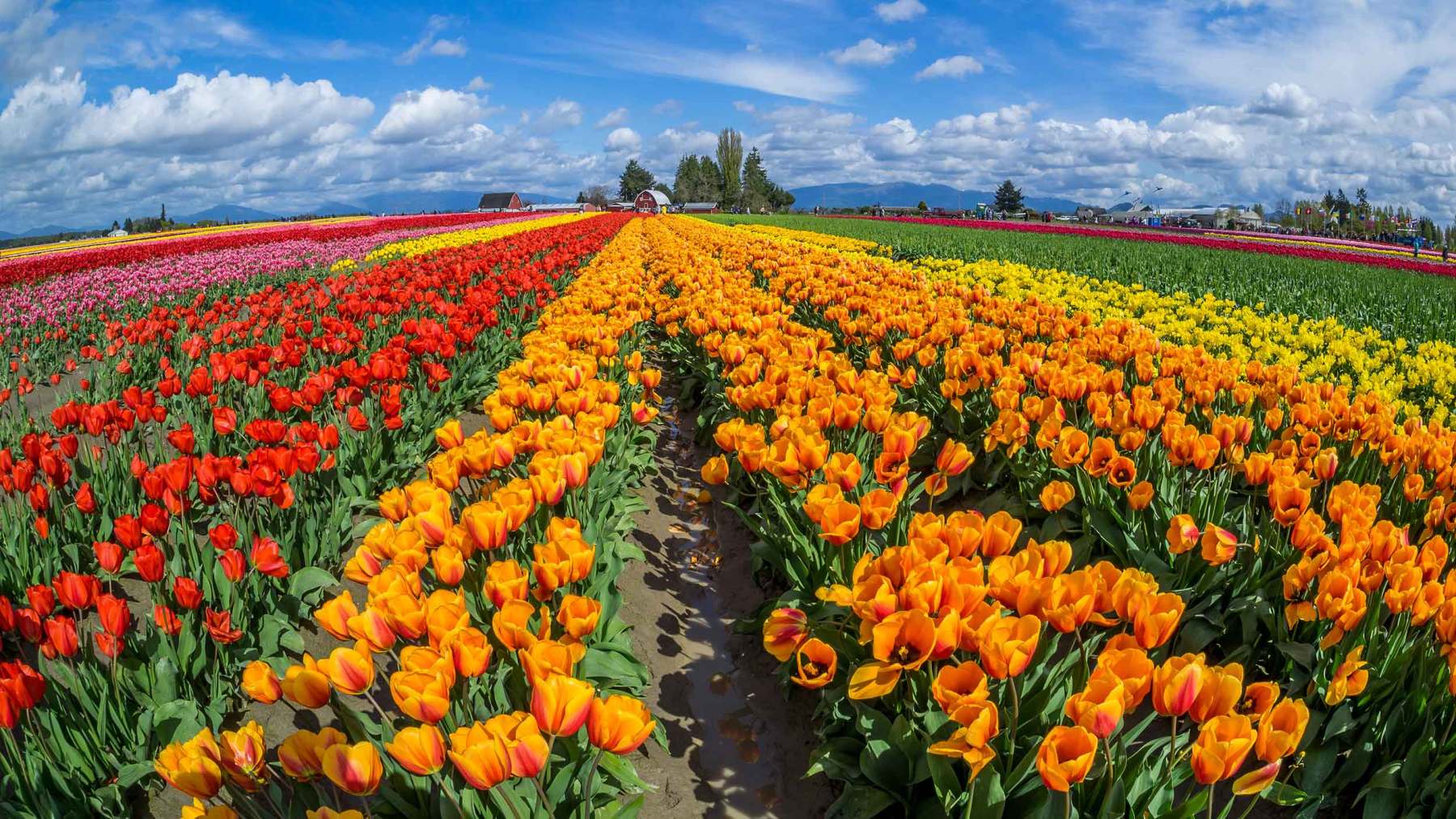
Tulip Time Festival in Holland, Michigan, is one of the most renowned tulip festivals in the United States. Held annually during the first week of May, this event celebrates Dutch heritage and showcases over 5 million tulips in various parks and gardens.
- Key attractions include:
- Dutch dance performances
- Artisan markets
- Musical concerts
- Trolley tours
The Canadian Tulip Festival occurs in Ottawa, Canada, from mid-May to late May. It is recognized as the world’s largest tulip festival, boasting over 1 million tulips on display in various locations throughout the city. Activities include:
- Fireworks show
- Culinary events
- Interactive family activities
- Guided tours
The Skagit Valley Tulip Festival is another noteworthy event in Washington State’s Skagit Valley. Spanning the entire month of April, it features:
- Stunning tulip fields
- Wine tastings
- Farmer’s markets
- Guided bike tours
| European Tulip Festivals | Country | Time |
|---|---|---|
| Keukenhof Gardens | Netherlands | Late March to Mid May |
| Amsterdam Tulip Festival | Netherlands | The entire month of April |
| Floralia Brussels | Belgium | Late April to Early May |
| Istanbul Tulip Festival | Turkey | Early April to Late April |
Visiting a tulip festival offers a unique opportunity to immerse in the dazzling beauty of vibrant tulip blooms, the epitome of springtime. These events not only showcase these stunning flowers but also provide engaging activities that cater to various interests.
Tulip Symbolism and Meaning
Tulips have been a popular spring flower for centuries, and their rich history speaks to their symbolism and meaning. Originating from Turkey and Persia, they were brought to Europe in the 16th century. This section will explore the various aspects of tulip symbolism throughout history and their meanings today.
In the 17th century, tulips became highly valued in the Netherlands due to their unique and beautiful appearance. This period, known as Tulipmania, saw tulip bulbs traded and sold at exorbitant prices. During this time, tulips were symbolic of wealth and prosperity, and the different colors of tulips were also given special meanings.
| Color | Meaning |
|---|---|
| Red | Love and passion |
| Yellow | Cheerfulness, sunshine |
| White | Purity and innocence |
| Pink | Affection and caring |
| Purple | Royalty and nobility |
| Orange | Energy and enthusiasm |
In modern times, tulips have continued to hold significant meanings in various cultures and occasions. For example, they are often used as a symbol of charity, with certain tulip events and sales raising funds for charities worldwide. Additionally, tulips have become representative of friendship and the celebration of spring.
While color symbolism has remained consistent for the most part, some changes have occurred. One notable example is the yellow tulip, which once represented unrequited love and jealousy but has since shifted to signify happiness and cheerful thoughts.
Another exciting element of tulip symbolism relates to their shape and structure. The flower’s form has been likened to a wine glass or a heart, reflecting the themes of love and deep emotion commonly associated with tulips. This distinctive shape has made tulips a beloved choice for gifts and garden enthusiasts.
Photography and Capturing Tulips
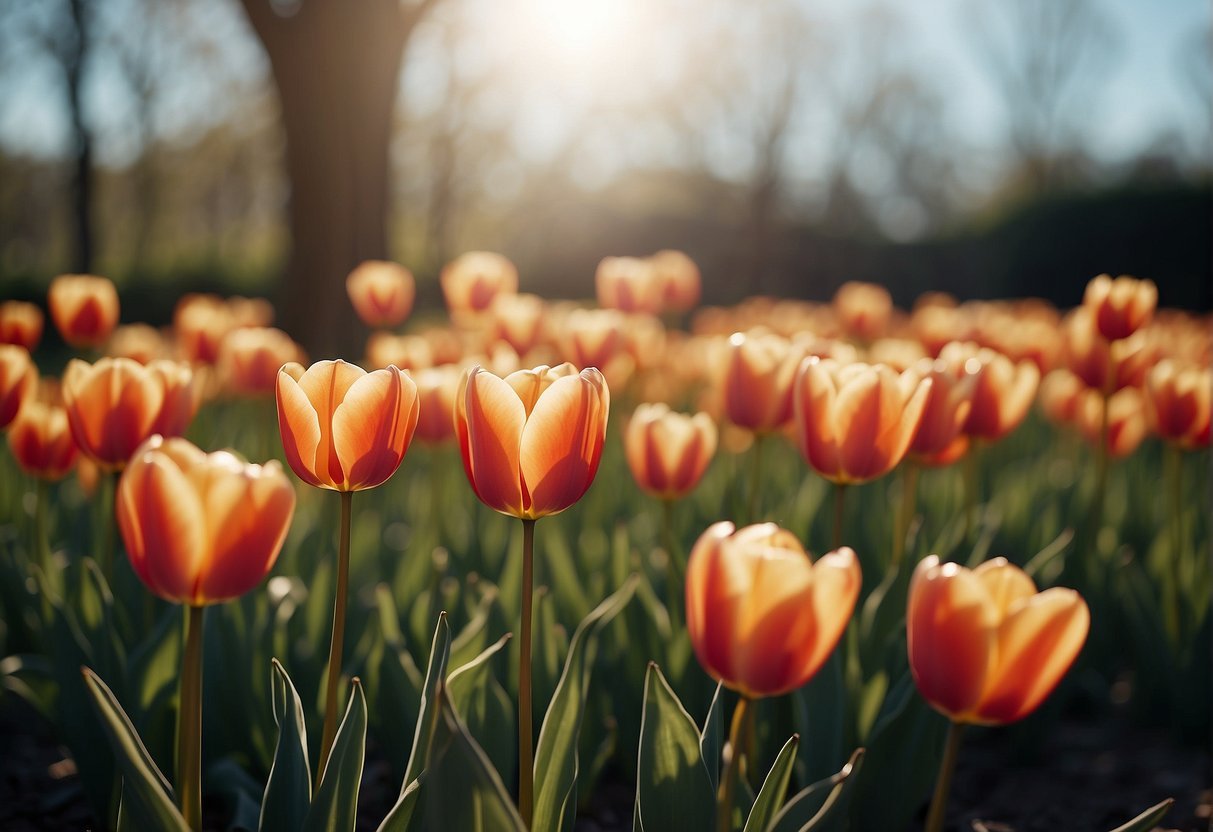
Best Practices
When photographing tulips, choosing the right time of day is essential. The golden hour—shortly after sunrise and before sunset—offers the most ideal lighting conditions. This period provides soft, warm, and diffused light, perfect for capturing tulips’ vibrant colors and delicate contours.
Properly framing your subject is crucial. When composing your shot, consider the Rule of Thirds. This rule states that an image can be divided into nine equal parts. Positioning the main subject along these lines or at their intersection points can create a more balanced and compelling photograph.
| Composition | Framing Techniques |
|---|---|
| Rule of Thirds | Place the subject along the lines or intersection points. |
| Leading Lines | , Use lines within the scene to guide the viewer’s eye. |
| Depth of Field | Apply a shallow depth of field to isolate tulips. |
Remember to experiment with different camera angles and perspectives. Low angles can emphasize tulips’ height and proud nature, while higher angles offer a unique bird-eye view.
Creative Techniques
For those looking to explore their creativity, experimenting with focus and depth of field can produce stunning results. Manual focus allows photographers to control which tulip remains sharp and in focus while the background or surrounding flowers become soft, creating a bokeh effect.
Introduce movement to your images by utilizing slow shutter speeds. Adding a slight breeze to the scene or intentionally shaking the camera during exposure can create a dreamy, painterly quality.
Zoom burst photography is an innovative technique for achieving a fresh perspective. By quickly zooming in or out while taking a photo, the tulips appear to burst from the center, producing a dynamic and fascinating image.
Lastly, don’t be afraid to experiment with post-processing. Simple adjustments to contrast, saturation, and color balance can elevate an image from ordinary to extraordinary.
Conservation and Sustainability
Biodiversity Preservation
Tulips contribute to biodiversity preservation by providing habitat and food for various species of insects, birds, and other animals. By growing tulips, gardeners are fostering a healthy ecosystem. However, it is essential to plant native tulip species, as non-native varieties may be invasive and outcompete indigenous plants. This can lead to monoculture, which is detrimental to biodiversity.
Some local tulip species to consider include:
- Tulipa sylvestris
- Tulipa bakeri
- Tulipa clusiana
Eco-Friendly Gardening Tips
Gardening with tulips can be environmentally friendly with some easy-to-follow tips:
- Plant organically: Avoid synthetic pesticides and fertilizers that can harm the ecosystem. Opt for organic alternatives instead.
- Save water: Implement drip irrigation systems or use rain barrels to collect and store rainwater.
- Encourage pollinators: Plant various tulip species with different blooming times throughout the season to provide nectar and pollen for bees, butterflies, and hummingbirds.
- Practice crop rotation: Avoid planting tulips in the same spot every year. Rotating your tulip beds can help prevent the buildup of diseases and pests.
- Use compost: Incorporating compost into the soil helps with nutrient cycling and supports healthy plant growth.
By following these guidelines, gardeners can ensure that their tulip gardens contribute to the conservation and sustainability of the local ecosystem.
Frequently Asked Questions
What are the best locations to view tulips in bloom during spring?
The Keukenhof Gardens in the Netherlands are renowned for their vibrant tulip displays. Other popular locations include the Skagit Valley Tulip Festival in Washington, USA, and the Ottawa Tulip Festival in Canada. Many botanical gardens and parks worldwide feature lovely tulip blooms during spring.
Is ‘Tulips in Spring’ available on any streaming platforms?
‘Tulips in Spring’ may be available on various streaming platforms, such as Netflix, Amazon Prime Video, or Hallmark Movies Now. Availability varies by region, so checking your local streaming services for current listings is recommended.
Who are the main actors in the Hallmark movie ‘Tulips in Spring’?
Fiona Gubelmann, Lucas Bryant, and Kelly Rowan are the main actors in the Hallmark movie Tulips in Spring.
Can I watch the trailer for ‘Tulips in Spring’ online?
Yes, the trailer for ‘Tulips in Spring’ can be found on video-sharing sites like YouTube and Vimeo and the Hallmark Channel’s official website.
Where can I find the full movie ‘Tulips in Spring’ to watch?
Depending on your region, the whole movie Tulips in Spring may be available on streaming services like Netflix, Amazon Prime Video, or Hallmark Movies Now. You can also check your local cable provider or satellite TV service for availability or purchase it from online retailers.
What is the filming location of the ‘Tulips in Spring’ movie?
‘Tulips in Spring’ was filmed in various locations throughout British Columbia, Canada. The region’s picturesque scenery lends itself well to the movie’s setting and storyline.